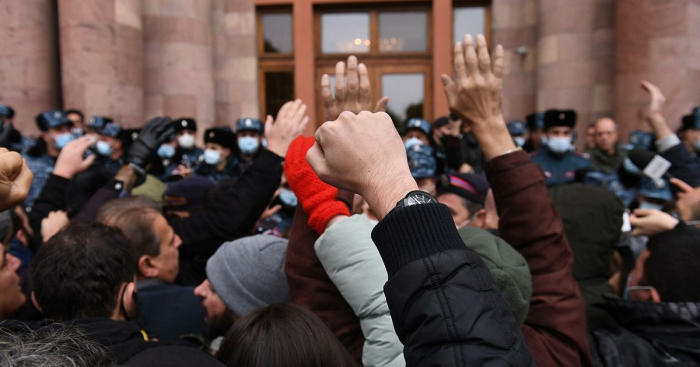Protest, soul-searching, pre-meeting adumbrations

By Orkhan Amashov
The protest that took place in central Yerevan on 5 April, the day prior to the Brussels meeting of Azerbaijani President Ilham Aliyev and Armenian Prime Minister Nikol Pashinyan, has received substantial coverage in both countries and beyond, and happens to be of some significance when one thinks of the soul-searching within Armenian nationalism, which has been going through its most lugubrious phase.
The self-declared organisers of the rally are known - they are the forces loyal to the former leaders, Serzh Sargsyan and Robert Kocharyan - who oppose the incumbent government, as they consider it to have adopted a defeatist and surrender policy over Karabakh, and believe any peace deal will be fatal. No surprise here.
What they do not concur with, in precise terms, is also far from being a secret. The revenge-induced dogmatism encapsulating their worldview demands that any step that may lead to a comprehensive and sustainable agreement, dictated by the results of the Second Karabakh War, with the former foe, must be blocked.
The steps that they find inadmissible correspond to the range of issues that fall within the preview of today’s meeting; they include the demarcation and delimitation of the Azerbaijani-Armenian state border; the opening of communication routes, including the Zangazur corridor; and the removal of the remaining separatist forces from Karabakh, the last item being particularly petrifying for those who have yet to come to terms with what the recent campaign has engendered.
However, the most important aspect of the whole story is not what the opposition wants, but to what extent Pashinyan himself may be interested in such a highly-publicised rally prior to facing President Aliyev in Brussels, where his hands will be forced. Many in Azerbaijan believe the protest was a theatrical performance of the disaffected, which was clandestinely encouraged by the incumbent prime minister himself.
One of the arguments put forward is that, despite its superficially anti-government tenets, the demonstration received favourable coverage by the media outlets supportive of Pashinyan, who will be able to use the fact of the discontent as evidence of the difficulties that any of the anticipated compromises could cause.
There is some logic to this assumption. It is a known method, put into practice by many leaders, to resort to an unfavourable internal political situation as an excuse to obviate the necessity of an unavoidably impending concession. The question is whether such a measure is being undertaken for tactical or strategic reasons.
If Pashinyan, whether or not he played any significant role in staging the April 5 demonstration, is contemplating using this in the light of tactical considerations with the purpose of achieving greater rights for the Armenian population in Karabakh, then such an outlook could be deemed understandable and even sensible, if one, for a moment, puts oneself in the Armenian leader’s ill-fitting shoes. After all, any negotiation is about bargaining chips and their effective use for advancing one’s aims and objectives.
However, if Pashinyan himself is involved in a certain larger regressive plot, aimed at reversing the consequences of the recent war, then the cause for concern should naturally be far greater.
Armenia is painstakingly striving to find an answer as to what it got wrong and what must be done to fix the issue. The completion of this existential task requires realism and courage to face the essence of the delusions of grandeur that have entrapped the country.
Armenia is a recovering patient with toxic habits which refuse to fade away. Full resuscitation is not in sight, as yet. So much poppycock and wishful thinking have been infested into the psyche of the nation that it will take some time before a sufficient degree of sobriety is achieved.
Pashinyan has occasionally shown discernible signs of half-hearted maturity and semi-resolve to address this malaise. The one possibility is that he has made a half-authentic diagnosis as to what went wrong, and has already taken a course, which amid its shortcomings and inconsistencies, is fundamentally correct, despite the full extent of its righteousness being questionable.
Back to the question concerning the place of the demonstration in Pashinyan’s thinking, the crucial point is as how it should be viewed in the context of the aforementioned soul-searching process, which is bound to manifest itself in some form of detoxification, as Armenia is a sick patient, addicted to myths, legends and unrealistic futurism.
And we know that soul purification of any variety is not a straight process of “withdrawal and extinction”. There are times a patient needs occasional injections of that very toxic substance, albeit in lower doses, that has caused the illness in the first place. What matters is whether the rally was an episode engineered with the purpose of easing the pain for tactical reasons, or indicative of avoidance of a full recovery.
---
Here we are to serve you with news right now. It does not cost much, but worth your attention.
Choose to support open, independent, quality journalism and subscribe on a monthly basis.
By subscribing to our online newspaper, you can have full digital access to all news, analysis, and much more.
You can also follow AzerNEWS on Twitter @AzerNewsAz or Facebook @AzerNewsNewspaper
Thank you!
